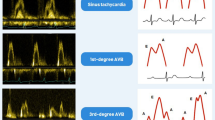Abstract
Objectives: We have previously developed current vector maps of tangential components on the magnetocardiogram (MCG) to obtain cardiac current distribution images. The present study was conducted to detect repolarization abnormalities in patients with cardiomyopathy using the current vector map. Subjects and methods: Thirteen patients with cardiomyopathy (nine males and four females aged 7–16 years, mean, 11.5 ± 3.1 years, ±SD), and 15 age- and sex-matched normal subjects were studied. Normal components (Bz) of MCG were measured at rest with a multi-channel superconducting quantum interface device (SQUID) system, and differentiated in the tangential direction to obtain current vector maps. Homogeneity of current in the heart during repolarization was investigated. The direction of the maximum current vector was also calculated in each case. Results: In all normal subjects, the current vector consistently showed a left downward direction on the frontal chest plane during the repolarization process. On the other hand, 8 out of 13 patients with cardiomyopathy showed different patterns; four of these patients showed multi-dipoles, and the other four showed a shift in the current vector direction. One of the eight cases showed no abnormality on electrocardiogram (ECG). Conclusions: Repolarization process in patients with cardiomyopathy was apparently different from those in normal subjects on the current vector map. It was easy to visualize the repolarization process as a projection to the frontal plane, including regional abnormalities, by the current vector maps, which might be more useful for early detection of repolarization abnormalities than ECG.
Similar content being viewed by others
References
Tsukada K, Haruta Y, Adachi A, et al. Multichannel SQUID system detecting tangential components of the cardiac magnetic field. RevSci Instrum 1995; 66: 5085–5091.
Tsukada K, Miyashita T, Kandori A, et al. Noninvasive visualization of activated regions and current flow in the heart by analyzing vector components of a cardiac magnetic field. Comput Cardiol 1999; 26: 403–406.
Tsukada K, Mitsui T, Terada Y, Horigome H, Yamaguchi I. Noninvasive visualization of multiple simultaneously activated regions on Torso magnetocardiographic maps during ventricular depolarization. J Electrocardiol 1999; 32: 305–313.
Horigome H, Tsukada K, Kandori A, et al. Visualization of regional myocardial depolarization by tangential component mapping on magnetocardiogram in children. Int J Cardiac Imag 1999; 15: 331–337.
Tsukada K, Kandori A, Miyashita T, et al. A simplified superconducting quantum interference device system to 169 analyze vector components of a cardiac magnetic field. Proceedings of 20th Annual International Conference of the IEEE Engineering in Medicine and Biology Society; 1998 October 29–November 1; Hong Kong: IEEE Engineering in Medicine and Biology Society, 1998.
Miyashita T, Kandori A, Tsukada K, et al. Construction of tangential vectors from normal cardiac magnetic field components. Proceedings of 20th Annual International Conference of the IEEE Engineering in Medicine and Biology Society; 1998 October 29–November 1; Hong Kong: IEEE Engineering in Medicine and Biology Society, 1998.
Tsukada K, Kandori A, Yoshida T, et al. Tangential component measurement of cardiac magnetic field and comparison with conventional z-component. 10th International Conference on Biomagnetism; 1996 February; Santa Fe, 1996: 565–568.
Cohen D, Lepeschkin E, Hosaka H, Massell BF, Myers G. Abnormal patterns and physiological variations in magnetocardiograms. J Electrocardiol 1976; 9: 398–409.
Nakaya Y, Sumi M, Saito K, Fujino K, Murakami M, Mori H. Analysis of current source of the heart using isomagnetic and vector arrow maps. Jpn Heart J 1984; 25: 701–711.
Fujino K, Sumi M, Saito K, et al. Magnetocardiograms of patients with left ventricular overloading recorded with a second-derivative SQUID gradiometer. J Electrocardiol 1984; 17: 219–228.
Nomura M, Fujino K, Katayama M, et al. Analysis of the T wave of the magnetocardiogram in patients with essential hypertension by means of isomagnetic and vector arrow maps. J Electrocardiol 1988; 21: 174–182.
Nomura M, Nakaya Y, Fujino K, et al. Magnetocardiographic studies of ventricular repolarization in old inferior myocardial infarction. Eur Heart J 1989; 10: 8–15.
Nakaya Y, Monura M, Fujino K, Ishihara S, Mori H. The T wave abnormality in the magnetocardiogram. Front Med Biol Eng 1989; 1: 183–192.
Hosaka H, Cohen D, Cuffin BN, Horacek BM. The effect of the Torso boundaries on the magnetocardiogram. J Electrocardiol 1976; 9: 418–425.
Hosaka H, Cohen D. Visual determination of generators of the magnetocardiogram. J Electrocardiol 1976; 9: 426–432.
Burchell HB. Clinical recognition of cardiac hypertrophy. Cir Res 1974; 34–35(Suppl II): 116–121.
Savage DD, Seides SF, Clark CE, et al. Electrocardiographic findings in patients with obstructive and nonobstructive hypertrophic cardiomyopathy. Circulation 1978; 58: 402–408.
Panza JA, Maron BJ. Relation of electrocardiographic abnormalities to evolving left ventricular hypertrophy in hypertrophic cardiomyopathy during childhood. Am J Cardiol 1989; 63: 1258–1265.
Pelliccia F, Cianfrocca C, Cristofani R, Romeo F, Reale A. Electrocardiographic findings in patients with hypertrophic cardiomyopathy. Relation to presenting features and prognosis. J Electrocardiol 1990; 23: 213–222.
Posma JL, van der Wall EE, Blanksma PK, van der Wall E, Lie KI. New diagnostic options in hypertrophic cardiomyopathy. Am Heart J 1996; 132: 1031–1041.
Hamby RI, Raia F. Electrocardiographic aspects of primary myocardial disease in 60 patients. Am Heart J 1968; 76: 316–328.
Oakley CM. Clinical recognition of the cardiomyopathies. Cir Res 1974; 34–35(Suppl II): 152–167.
Basso C, Thiene G, Corrado D, Buja G, Melacini P, Nava A. Hypertrophic cardiomyopathy and sudden death in the young: pathologic evidence of myocardial ischemia. Hum Pathol 2000; 31: 988–998.
Roberts WC, Siegel RJ, McManus BM. Idiopathic dilated cardiomyopathy: analysis of 152 necropsy patients. Am J Cardiol 1987; 60: 1340–1355.
Tsukada K, Miyashita T, Kandori A, et al. An iso-integral mapping technique using magnetocardiogram, and its possible use for diagnosis of ischemic heart disease. Int J Cardiac Imag 2000; 16: 55–66.
Shiono J, Horigome H, Matsui A, et al. Evaluation of myocardial ischemia in Kawasaki disease using iso-integral map on magnetocardiogram. PACE 2002; 25: 915–921.
Author information
Authors and Affiliations
Rights and permissions
About this article
Cite this article
Shiono, J., Horigome, H., Matsui, A. et al. Detection of repolarization abnormalities in patients with cardiomyopathy using current vector mapping technique on magnetocardiogram. Int J Cardiovasc Imaging 19, 163–170 (2003). https://doi.org/10.1023/A:1022823217232
Issue Date:
DOI: https://doi.org/10.1023/A:1022823217232




